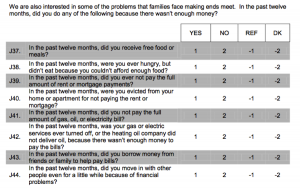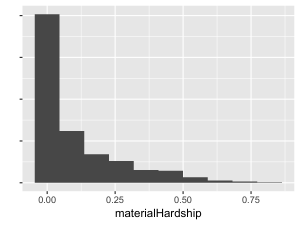Material hardship

Material hardship is a measure of extreme poverty.
We want to know:
- What helps families to unexpectedly escape extreme poverty?
- What leads families to fall into extreme poverty unexpectedly?
Survey questions


How we cleaned the data
These questions were asked of the child’s primary caregiver when the child was approximately age 15. We marked as NA material hardship for children whose caregivers did not participate in the survey, didn’t know the answer to one or more questions, or refused one or more questions. Our material hardship measure is the proportion of these 11 questions for which the child’s caregiver answered “Yes.” Material hardship ranges from 0 to 1, with higher values indicating more material hardship.
Distribution in the training set

Scientific motivation
In his 1964 State of the Union Address, President Lyndon B. Johnson declared an “all-out war on human poverty and unemployment in these United States.” In the decades since, America has taken great strides toward this goal. However, severe deprivation remains a problem today. In $2 a Day: Living on Almost Nothing in America, Johns Hopkins sociologist Kathryn Edin and University of Michigan social work professor H. Luke Schaefer bring us into the lives of American families living in the nightmare of extreme poverty.
What can be done to reduce extreme poverty? By identifying families who unexpectedly escape extreme poverty, as well as those who unexpectedly fall into it, we hope to uncover unmeasured but important factors that affect severe deprivation.
Measuring extreme poverty is hard. The material hardship scale was originally proposed in a 1989 paper by Susan Mayer and Christopher Jencks, then social scientists at Northwestern University. Rather than focusing solely on respondent’s incomes, Mayer and Jencks asked respondents about particular needs that they were unable to meet. This scale proved fruitful and captured a dimension of poverty above and beyond what was captured by income alone. With minor modifications, the material hardship scale became a standard measure in the federal Survey of Income and Program Participation (SIPP), and it has been included in several waves of the Fragile Families Study.
By participating, you help us to identify the level of material hardship that is expected at age 15 for each of the families in the Fragile Families Study. By combining all of the submissions in one collaborative model, we will produce the best guess by the scientific community of the experiences we expect for families at age 15. Undoubtedly, some families will report much more or much less material hardship than we expect. By interviewing these families, we hope to discover unmeasured but important factors that are associated with sudden dives into material hardship or unexpected recoveries.
The results of these exploratory interviews can then inform future deductive social science research and help us propose policies that could help families to escape severe deprivation. You can help us to target these interviews at the families best positioned to help. Be a part of the solution: apply to participate, build a model, and upload your contribution.

Add your comment